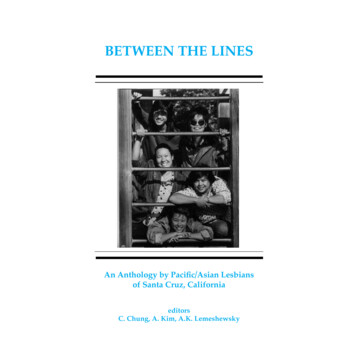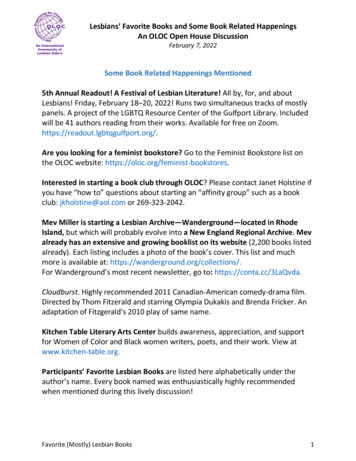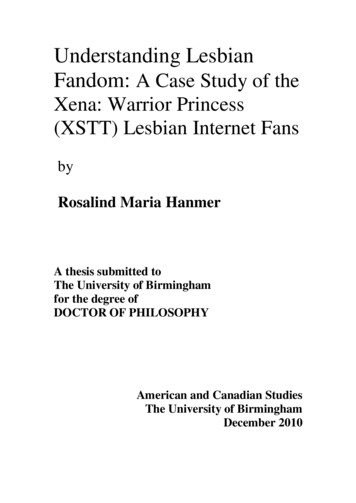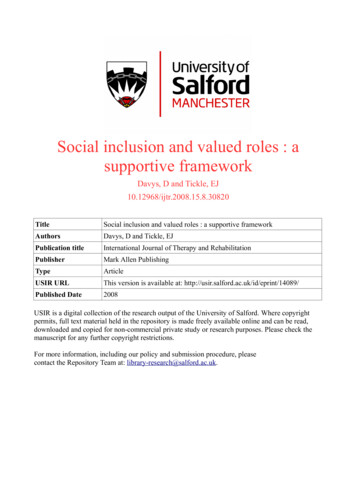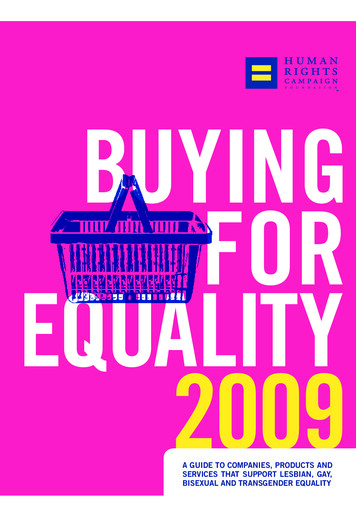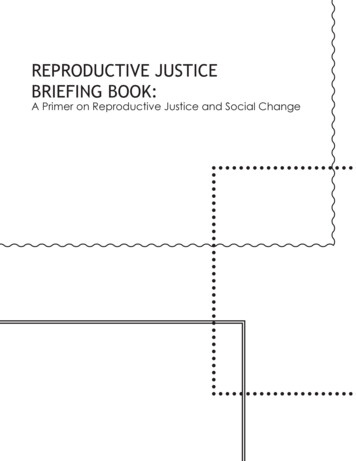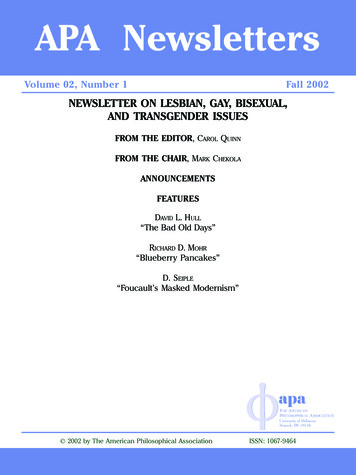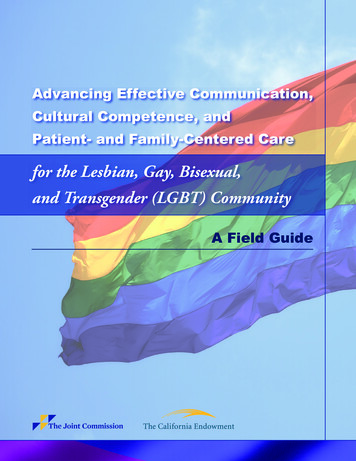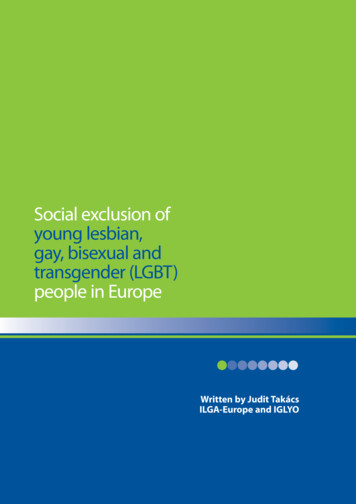
Transcription
Social exclusion ofyoung lesbian,gay, bisexual andtransgender (LGBT)people in EuropeWritten by Judit TakácsILGA-Europe and IGLYO
IGLYOThe European Region of the InternationalLesbian and Gay AssociationInternational Lesbian, Gay, Bisexual, Transgender, QueerYouth and Student Organisation (IGLYO)avenue de Tervueren 941040 Brussels BelgiumTelephone: 32 2 609 54 10 Fax: 32 2 609 54 19P.O. Box 38361001 AP Amsterdam The Netherlandsinfo@ilga-europe.org www.ilga-europe.orginfo@iglyo.com www.iglyo.com ILGA-EuropeReproduction permitted,provided that appropriatereference is made to the source.This reportis published with the support of theEuropean Commission – The European Unionagainst discrimination. The information containedin this publication does not necessarily reflectthe position or opinion of the European Commission.Layout: Silja Pogulewww.siljadesign.lvPrinter: Sofadiwww.sofadi.be
Social exclusion ofyoung lesbian, gay,bisexual andtransgender (LGBT)people in EuropeApril 2006Written by Judit TakácsILGA-Europe and IGLYO
ContentSocial exclusion of young lesbian, gay, bisexual and transgender (LGBT) people in EuropeIntroduction6Chapter 1. Social inclusion and social exclusion at the European level101.1. Defining social inclusion and social exclusion111.2 “Including the excluded” in the EU social inclusion policy process13Chapter 2. Mechanisms of social exclusion affecting young people in general172.1 Autonomy172.2. Transition from education into employment182.3 Participation and citizenship19Chapter 3. Understanding social exclusion of LGBT people21Chapter 4. The main fields of social exclusion of young LGBT people244.1 Invisibility244.2 Mental health284.3 School environment30Chapter 5. Personal accounts of European young LGBT people on social exclusion375.1. Methodology375.2. Findings395.2.1. Family405.2.2. School475.2.3. Peer group/Friends’ circle595.2.4. Community615.2.5. Religious community665.2.6. Media705.3. Summary of results: Causes of social exclusion of young LGBT people725.3.1 A note about the sample76Chapter 6. Good practices to promote social inclusion of LGBT youth77Recommendations90Annex I – Inclusion of LGBT youth in National Action Plans on Social Inclusion94Annex 2 – Individual and organisational questionnaires97Bibliography99Glossary103
Social exclusionof young lesbian,gay, bisexualand transgender(LGBT) peoplein EuropeForewordThis publication is the outcome of a fruitful and constructive partnership between ILGA-Europe and IGLYO,the International Gay, Lesbian, Bisexual, Transgender and Queer Youth and Student Organization.Initiated by Birgit Hardt, who put social inclusion of young LGBT people on our agendas and brought our twoorganisations together, this research project was enriched by the ongoing contribution of numerous people.The members of the research steering team, Peter Dankmeijer, Kim Smouter and Patricia Prendiville,provided valuable guidance on the methodology and the thinking on the issue of social exclusion of LGBTyouth, as well as important feedback on drafts of this report.Many people have contributed their time to help us produce this publication in an inclusive fashion bytranslating the questionnaires sent to young people in different languages: Roman Kuhar, Greg Czarnecki,Chris Swart, Cristian Nita, Linda Elstad, Andreas Nilsson, Jelena Chelebic, Katerina Nedbalkova, TiagoLopes, Anna Kirey, Anke Bienwald, Eddy, Notty and Ana, Fabio Saccá and Maxence de Barros. Many othershave provided assistance in making sure that the questionnaires would reach young people by sharingtheir technical skills and resources, and in helping the research team process the data collected (AttilaBartha, Katherine Fobear, Beverley Craig, as well as those behind the websites www.gay.nl, www.gay.be,www.gay.hu and www.pride.hu ). We also thank Nate Nicholson, James Adutt and Chris ChristiaanszUngerer who proofread the report.Our special thanks go to all the young lesbian, gay, bisexual and transgender people who shared theirthoughts and experiences with us. Their testimonies are the heart of this publication, and testify to theneed of combating discrimination and exclusion of young LGBT people.Finally, we wish to thank the author, Judit Takács, not only for the high quality of this report, but also forher genuine enthusiasm, dedication and commitment to giving a voice to young people. We believe thatthis publication will make an important contribution to the work of our two organisations towards greatersocial inclusion of young LGBT people.Evelyne Paradis (ILGA-Europe) and Björn van Roozendaal (IGLYO)On behalf of the Research Steering Team5
Social exclusionof young lesbian,gay, bisexualand transgender(LGBT) peoplein EuropeIntroductionBackgroundLesbian, gay, bisexual and transgender (LGBT) people continue to face discrimination and exclusion acrossEurope in all spheres of life. Homophobic violence and abuse targeting LGBT people occur on a regularbasis. In most EU Member States, same-sex couples do not enjoy the same rights and protections asopposite sex couples, and consequently suffer from discrimination and disadvantage in access to socialprotection schemes, such as health care and pensions. In the labour market, a majority of LGBT peoplecontinue to hide their sexual orientation or to endure harassment out of fear of losing their job.Particularly vulnerable are young LGBT people who experience estrangement from family and friendshipnetworks, harassment at school and invisibility, which can lead in some cases to underachievement atschool, school drop-out, mental ill-health and homelessness. This discrimination not only denies LGBTpeople equal access to key social goods, such as employment, health care, education and housing, but italso marginalises them in society and makes them one of the vulnerable groups who are at risk ofbecoming socially excluded.Although tackling social exclusion in the Member States of the European Union (EU) has been anobjective since the launch of the Lisbon Strategy in 2000, little attention has been paid to the exclusionthat LGBT people experience in the context of European social policy, and in particular the EU socialinclusion strategies. Yet, EU Member States have made many commitments to combating discriminationon the ground of sexual orientation within the EU, including by inscribing the principle of nondiscrimination on this ground in European policy-making through Article 13 of the Amsterdam Treaty andthe adoption of the Employment Equality Directive (2000/78). In fact, the link between discrimination andsocial exclusion has been recognised by the European Commission and the European Council on anumber of occasions (as will be discussed in Chapter 1). However, there is a real need to bring equalityand non-discrimination considerations into the core of European social policy-making and especially theEU social inclusion process, for discrimination remains one of the main causes of exclusion.This joint IGLYO and ILGA-Europe project is a response to the need to bring to attention the socialexclusion of young LGBT people in Europe. Drawing from ILGA-Europe’s expertise in the field of EU policymaking and IGLYO’s network of LGBT youth across Europe, this publication provides a comprehensive review6
Social exclusionof young lesbian,gay, bisexualand transgender(LGBT) peoplein Europeof the mechanisms of social exclusion which affect young LGBT people and it illustrates the everydaydiscrimination and marginalisation which LGBT youth continue to experience in all EU Member States.AimThus, the first aim of this report is to contribute to national and European policy-makers’ understanding ofthe need to formulate social inclusion policies that bear in mind the specific needs of LGBT people, andespecially in the context of the EU social inclusion process. The report seeks to do this by highlighting theeffect that discrimination on the ground of sexual orientation and gender identity has on LGBT people’scapacity to participate fully in society and be included in all areas of life.A second objective of this report is to raise awareness about the need to take into consideration howmultiple forms of discrimination interact to put people at a particular disadvantage and risk of exclusion.To this end, the main focus of this research was placed on young LGBT people. On one hand, youngpeople have repeatedly been identified as a group particularly vulnerable to social exclusion and poverty,including by the European Council in the European Youth Pact adopted in 2005. The improvement of thesituation of the most vulnerable young people was also made one of the key components of Europeanyouth policies by the European Commission (European Commission, COM (2005) 206 final). Yet, there islittle awareness of the particular vulnerability of young LGBT people and limited understanding of thedouble disadvantage which these young people suffer because of their age and their sexual orientation, adisadvantage which can sometimes be increased by discrimination on grounds of sex, gender, disability,ethnic origin or religion. By bringing to light the existence of multiple forms of discrimination which havean impact of social inclusion of young LGBT people, this research wants to stress the importance oflooking at all the factors which make people vulnerable to exclusion.To achieve these two aims, the report examines the main mechanisms of social exclusion which affectyoung LGBT people as young people and LGBT people, in relation to education, health, employment andactive citizenship. It establishes that young LGBT people can be socially excluded as a result of socioeconomic factors (such as low income; unemployment; poor education, health, and housing conditions)and as a result of discrimination based on their sexual orientation which affects their ability to realise theirautonomy and their citizenship rights.This study emphasises the effects of the discrimination that young LGBT people encounter in their family,7
Social exclusionof young lesbian,gay, bisexualand transgender(LGBT) peoplein Europeat school and in their community, on their ability to manage the transition from school to work, and tobecome autonomous adults and active citizens. The evidence collected in this report demonstrates howthe various forms of discrimination that young LGBT people experience – such as estrangement fromfamily networks, the sense of isolation and invisibility they experience at school and in society, as well asthe harassment they are exposed to – reach all spheres of their life. In the educational setting, young LGBTpeople not only face the threat of homophobic bullying and harassment, but they also encounterstructural levels of discrimination related to the lack of representation of homosexuality, bisexuality andgender identity in the education curriculum. Such factors have a negative impact on their achievement atschool and access to education which in turn has negative effects on managing the transition from schoolto work. The harassment and discrimination experienced also makes LGBT youth more prone to mentalhealth problems due to stress and low self-esteem, thereby increasing the risk of being isolated andexcluded within their community.ContentThere are seven sections in this report. The first chapter reviews the definitions of the concept of socialinclusion and social exclusion, as well as the commitments made by EU Member States in the field of socialinclusion and non-discrimination in order to situate the analysis of the social exclusion of LGBT youth inthe context of EU policy-making. Chapters 2 and 3 sketch the main characteristics of social exclusion ofyoung people (chap. 2) and of LGBT people (chap.3) as a way to understand what are the principalmechanisms of exclusion specifically affecting these two groups. The fourth chapter presents a literaturereview of existing academic and community-based research and data which provides evidence of thesocial exclusion that young LGBT people experience in society. In particular, this section provides areflection on the ‘coming out’ process and the issue of visibility of young LGBT people in society, policymaking and in research. It also looks at harassment, bullying and lack of representation of LGBT youth ineducational setting, and at mental health problems which may result from discrimination, isolation andharassment.The following chapter (chap.5) presents an original survey conducted by the ILGA-Europe and IGLYO socialexclusion research team amongst young LGBT people from 37 countries across Europe. The personalaccounts collected from 754 individuals depict the everyday life of young gay, lesbian, bisexual andtransgender people and their experiences of discrimination within their family, amongst friends, at school,in their community, and in the media. This qualitative data provides further evidence of how social8
Social exclusionof young lesbian,gay, bisexualand transgender(LGBT) peoplein Europeexclusion mechanisms work to prevent the successful social integration of young LGBT people in Europe.The concluding sections of this report include a compilation of good practices – i.e. projects and policiescarried out in different EU Member States, which contribute to greater inclusion and recognition of LGBTyouth – and recommendations for EU institutions and Member States to promote social inclusion ofyoung LGBT people. These good practices and recommendations will hopefully contribute to a strongercommitment from all actors involved in the social inclusion process, in particular EU Member States andinstitutions, to fully integrate LGBT young people in social inclusion policies and programmes.9
Social exclusionof young lesbian,gay, bisexualand transgender(LGBT) peoplein Europe1. Social inclusion andsocial exclusion at theEuropean levelSocial inclusion, as an objective of the European Union and a European policy strategy, was put on theEuropean Social Policy Agenda at the Nice European Council in December 2000. The fight against povertyand social exclusion was introduced onto the EU agenda as one of the central elements of the LisbonStrategy launched at the European Council in March 2000. The EU Social Inclusion Process was identifiedas one of the strategies to achieve the goal of the Lisbon Strategy which is to make the European Union themost dynamic, competitive, knowledge-based economy in the world, while ensuring that the benefits of theEU’s growth reach everyone in society and that the policies are environmentally sustainable by 2010.Promoting social inclusion and combating discrimination – on grounds listed in Article 13 of the Treaty ofAmsterdam1 – were both featured among the main objectives and actions of the EU Social Policy Agendafor 2000-2005, which was aimed at “modernising the European social model” in the context of the LisbonStrategy.2 These objectives were reiterated in the most recent social agenda, published by the EuropeanCommission in 2005, which sets the achievement of “a more cohesive society” and “equal opportunities forall” as one of its two priority areas (European Commission, COM (2005) 33 final).The new framework for social protection and social inclusion policies issued by the EU in 2005 further detailsthese objectives, while reasserting the link between exclusion and discrimination (European Commission,COM(2005) 706 final). This document defines the following as specific objectives of the Social Inclusion Process:1Article 13 of Treaty of Amsterdam – “Without prejudice to the other provisions of this Treaty and within the limits of the powersconferred by it upon the Community, the Council, acting unanimously on a proposal from the Commission and after consulting theEuropean Parliament, may take appropriate action to combat discrimination based on sex, racial or ethnic origin, religion or belief,disability, age or sexual orientation.”2Among the objectives and actions listed in the Social Policy Agenda are the following:“To prevent and eradicate poverty and exclusion and promote the integration and participation of all into economic and social life.”And “To ensure the development and respect of fundamental social rights as a key component of an equitable society and of respectfor human dignity” (See European Commission COM (2000) 379 final).10
Social exclusionof young lesbian,gay, bisexualand transgender(LGBT) peoplein Europe To “ensure the active social inclusion of all by promoting participation in the labour market andby fighting poverty and exclusion among the most marginalised people and groups” (emphasis added) To “guarantee access for all to the basic resources, rights and social services needed forparticipation in society, while addressing extreme forms of exclusion and fighting all forms ofdiscrimination leading to exclusion” (emphasis added).While the promotion of social inclusion is an important objective of EU policies, it is important to keep inmind that the most recent social agenda and the objectives of the social inclusion process were adoptedat a time when the European debate was dominated by the economic challenges faced by the EU and therefocusing of the Lisbon Strategy towards growth and employment. This refocusing has beenaccompanied by an increasingly wide-spread understanding of social policy as a means to achieveeconomic growth and employment in the context of EU policy-making.This report seeks to argue for the benefits of social inclusion policies on their own terms, and not only as ameans of achieving growth and employment objectives. As this report will show, forms of exclusionendure throughout the EU which can only be appropriately tackled by fighting discrimination whichprecludes individuals, such as LGBT people, from being able to fully participate in society as well as in thelabour market, and from accessing all their rights.1.1. Defining social inclusionand social exclusionIn order to promote and advance a policy of social inclusion, it is important to be clear about the problemit seeks to tackle, i.e. social exclusion. There is not a single understanding of social exclusion either amongacademics or among policy-makers, but it is increasingly acknowledged that the concept has a broadermeaning than poverty.3 In a book published by the International Labour Organization (ILO) in 2003, JordiEstivill explains that “social exclusion may be understood as an accumulation of confluent processes withsuccessive ruptures arising from the heart of the economy, politics and society, which gradually distancesand places persons, groups, communities and territories in a position of inferiority in relation to centres ofpower, resources and prevailing values” (Estivill 2003).3See “List of some definitions at EU and International Levels” in Mainstreaming Social Inclusion Project (2006), p. 76.11
Social exclusionof young lesbian,gay, bisexualand transgender(LGBT) peoplein EuropeThe EU institutions have also put forward definitions of social exclusion which points to the exclusion ofpeople from multiple spheres of life and the inability to fully participate in societal life, and which includesnon-income related exclusion.4 In the 2004 Joint Report on Social Inclusion, the European Commissionand European Council defined social exclusion as a:“process whereby certain individuals are pushed to the edge of society and prevented fromparticipating fully by virtue of their poverty, or lack of basic competencies and lifelong learningopportunities, or as a result of discrimination. This distances them from job, income and educationand training opportunities as well as social and community networks and activities. They have littleaccess to power and decision-making bodies and thus often feel powerless and unable to take controlover the decisions that affect their day to day lives”. (European Council 2004)The European Commission has also acknowledged that social exclusion often occurs in various andoverlapping areas. In its Communication ‘Building an Inclusive Europe’, it is explained that “social exclusiongoes beyond issues of unemployment and access to the labour market. It is evidenced by several types ofdeprivation and barriers, which alone or together prevent the full participation in areas such as education,health, environment, housing, culture, access to rights or family support, as well as training and jobopportunities”(European Commission, COM(2000) 79 final).By understanding social exclusion as being the result of societal aspects, attitudes, and perceptions whichcreate an environment in which people are not fully able to participate in societal life, it becomes possibleto see that not all excluded people are living in poverty or vice versa. Some have indeed argued thatincome can be interpreted only as “an imperfect proxy for inclusion or exclusion as even many non-poormay suffer from social exclusion as the same income may generate widely varying capabilities for differentpeople because of their inherent diversity and as a result of inherent disadvantages by birth, background,or environment. Moreover, many elements of social ‘inclusion’ cannot be purchased simply with money asthey are public goods that are under-provided by markets and therefore depend on public provision (orpublic support for private provision) or are directly dependent on public policy” (Klasen 2002: 11).It is therefore important to adopt a more inclusive scope and context of social exclusion, especially whenaddressing social exclusion of LGBT people which cannot be defined strictly in socio-economic terms. Oneapproach is to focus on the lack of full social, economic and cultural participation opportunities for4“Social exclusion does not only mean insufficient income. It even goes beyond participation in working life; it is manifest in fieldssuch as housing, education, health and access to services. It affects not only individuals who suffered serious set-backs but socialgroups, particularly in urban and rural areas, who are subject to discrimination, segregation or the weakening of the traditional formsof social relations.” European Commission, COM (1993) 551.12
Social exclusionof young lesbian,gay, bisexualand transgender(LGBT) peoplein Europeindividuals and social groups, as well as their social powerlessness regarding their ability to represent theirinterests as factors determining social exclusion. Doing so entails defining social cohesion as the capacityof a society to ensure the welfare of all its members and as a solidarity-creating strategy to tackle differentforms of exclusion by means of both prevention and cure (Council of Europe, CDCS (2004)10). Anothercomponent of social exclusion, which is crucial to LGBT people, is their lack of recognition as full membersof a community and as citizens, as will be discussed in Chapter 3.In this respect, it is important to note that EU institutions have defined social inclusion – the solution tosocial exclusion – to reflect the breadth and complexity of social exclusion processes. The 2004 JointReport on Social Inclusion presents social inclusion as “a process which ensures that those at risk ofpoverty and social exclusion gain the opportunities and resources necessary to participate fully ineconomic, social and cultural life and to enjoy a standard of living and well-being that is considerednormal in the society in which they live. It ensures that they have greater participation in decision-makingwhich affects their lives and access to their fundamental rights (as defined in the Charter of FundamentalRights of the European Union).” (European Council 7101/04, March 2004)1.2 “Including the excluded” inthe EU social inclusion policyprocessPolicy objectives and definitions adopted by EU institutions have reflected an understanding of socialexclusion which acknowledges the multi-dimensional nature of social exclusion, and which consequentlyprovides a basis for calls for expanding policies to address social exclusion of LGBT people. To this end, it isimportant to look at how these objectives have been translated in policy-making terms, and in particular tohighlight: 1) the importance of taking into consideration the whole range of fields where social exclusiontakes place, and 2) the importance of recognising the diversity of people experiencing exclusion.EU institutions have acknowledged that social exclusion occurs in a variety of fields and that it is notlimited to employment. In a European Council report from 2002, it was acknowledged that “poverty andsocial exclusion take complex and multi-dimensional forms which require the mobilisation of a widerange of policies” and that “alongside employment policy, social protection as well as other importantfactors such as housing, education, health, information and communications, mobility, security and13
Social exclusionof young lesbian,gay, bisexualand transgender(LGBT) peoplein Europejustice, leisure and culture must also be taken into consideration” in the fight against poverty and socialexclusion (European Council 2002, 14164/1/02 REV 1).Despite this statement, EU policies have tended to focus mainly on employment-related and incomerelated exclusion, and to considerably limit the attention paid, for example, to the intersection betweenexclusion and discrimination in education and health. Indicative of this trend are the indicators defined inthe framework of the Open Method of Co-ordination (OMC) and the National Action Plans on Inclusion(NAPs/Inc), the main tools used by the EU to implement the Social Inclusion Process.5 The EuropeanCommission has promoted the use of the indicators by Member States as a means of comparing bestpractice and measuring progress at the national level. However, the list of the primary indicators of socialexclusion, developed by the Social Protection Committee and adopted by the European Council in 2002,includes mainly income and unemployment related items (Social Protection Committee 2001). The onlynon-income related indicators are the percentage of early school leavers and self perceived health statusof the population. A similar approach is put forward in the document issued by Eurostat in 2005 entitled“In-Work Poverty: New commonly agreed indicators at the EU level” (Bardone – Guio 2005).This being said, the multiplicity of fields of exclusion is more clearly reflected in the priorities set toencourage Member States to develop focused measures to address social exclusion. As defined in the2005 Joint Report on Social Protection and Social Inclusion – and reaffirmed in the 2006 Joint Report –Member States should develop policies and measures around the following seven priorities: 1) increasinglabour market participation; 2) modernising social protection systems; 3) tackling disadvantages ineducation and training; 4) eliminating child poverty; 5) ensuring decent accommodation; 6) improvingaccess to quality services; 7) overcoming discrimination and increasing the integration of people withdisabilities, ethnic minorities and immigrants (European Commission, COM(2005)14 final).These priorities do provide ground for Member States to work on exclusion in education, housing andhealth in addition to exclusion from the labour market, and they do define combating discrimination as apriority for the NAPs/Incl. However, the challenge lies in persuading Member States to address nonincome related exclusion and discrimination in their NAPs/Incl. For, according to the 2006 guidelines forpreparing the NAPs/Incl, Member States do have to pursue all seven objectives; they are invited to identify5In the context of the OMC, Member States agree on common policy objectives and common indicators to evaluate progress madetowards these objectives, but it is up to the Member States to formulate their own action and policies to meet the commonobjectives according to what they consider to be priorities in their respective country. These national programmes are presented tothe European Commission in the form of National Action Plans on Inclusion (NAPs/Inc). It should be noted that the competency ofthe EU in relation to the fight against poverty and social exclusion is to promote cooperation between Member States (based onArticle 136 of the Treaty of Amsterdam).14
Social exclusionof young lesbian,gay, bisexualand transgender(LGBT) peoplein Europe3 or 4 priority policy objectives which better correspond to national needs. Hence, the development ofmeasures which address discrimination targeting groups like LGBT people and youth in particular,depends on the goodwill of public authorities.However, as mentioned earlier (see point 1.1), focusing too much on income-related exclusion precludespublic authorities from developing measures which would help tackle many underlying causes ofexclusion, such as discrimination and violence at school. In the framework of the seven priorities listedabove, it is important to promote a wider recognition of the diversity of experiences of exclusion in orderto develop policies which tackle all underlying causes or factors of exclusion. For instance, as will bediscussed later on in this report, policies to tackle disadvantages in education should address issues ofbullying and harassment towards youth, including towards LGBT youth. Discrimination at school is animportant factor influencing performance at school and ultimately may have an impact on a youngperson’s transition from school to the workplace and his/her inclusion in other spheres of life.The second element to stress in relation to policy-making is the importance of ensuring recognition of thediversity of everyone experiencing exclusion when defining the groups at risk of exclusion and poverty.Acknowledging the various forms of exclusion faced by certain groups, especially where social exclusion isnot exclusively or primarily linked to the labour market, is a first step towards addressing their needs. Butit is also important to identi
young lesbian, gay, bisexual and transgender (LGBT) people in Europe Written by Judit Takács ILGA-Europe and IGLYO. The European Region of the International Lesbian and Gay Association avenue de Tervueren 94 1040 Brussels Belgium Telephone: 32 2 609 54 10 Fax: 32 2 609 54 19

